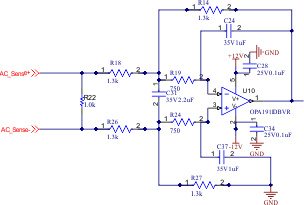TIDUF04 December 2022
- Description
- Resources
- Features
- Applications
- 5
- 1System Description
-
2System Overview
- 2.1 Block Diagram
- 2.2
Design Considerations
- 2.2.1
Isolated AC/DC Power Supply Design
- 2.2.1.1 Input Bulk Capacitance and Minimum Bulk Voltage
- 2.2.1.2 Transformer Turns-Ratio, Primary Inductance, and Primary Peak Current
- 2.2.1.3 Transformer Parameter Calculations: Primary and Secondary RMS Currents
- 2.2.1.4 Main Switching Power MOSFET Selection
- 2.2.1.5 Rectifying Diode Selection
- 2.2.1.6 Output Capacitor Selection
- 2.2.1.7 Capacitance on VDD Pin
- 2.2.1.8 Open-loop Voltage Regulation Versus Pin Resistor Divider, Line Compensation Resistor
- 2.2.1.9 Feedback Elements
- 2.2.1.10 Backup Power Supply
- 2.2.1.11 Supercapacitor Selection
- 2.2.1.12 Supercapacitor Charger Design
- 2.2.2 Control Pilot Signal Interface
- 2.2.3 Relay Drive and Weld Detect
- 2.2.4 Residual Current Detection
- 2.2.1
Isolated AC/DC Power Supply Design
- 2.3 Highlighted Products
- 3Hardware, Testing Requirements, and Test Results
- 4Design and Documentation Support
- 5About the Author
2.2.4.6 Differential to Single-Ended Converter
The differential to single-end conversion is performed by the first part of the signal chain. The first op amp converts the differential signal across the fluxgate burden resistor to a single-ended signal. This simplifies later signal conditioning and allows the ADC to read a ground referenced signal. R22 is the burden resistor across the coils of the fluxgate sensor.
Impedance matching to op amp inputs is important to minimize error. Mismatched impedance adds error to the fault detection signal. Trace from R22 to U10 can be similar to reduce error. To increase the ground fault signal, replace R18 and R26 with buffer op amps or resistors an order of magnitude larger. A higher impedance relative to the burden resistor (R22) gives a higher ground fault signal due to the resistor divider effect.
 Figure 2-12 Differential to Single-Ended Schematic
Figure 2-12 Differential to Single-Ended Schematic